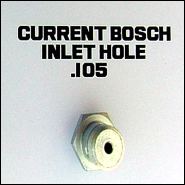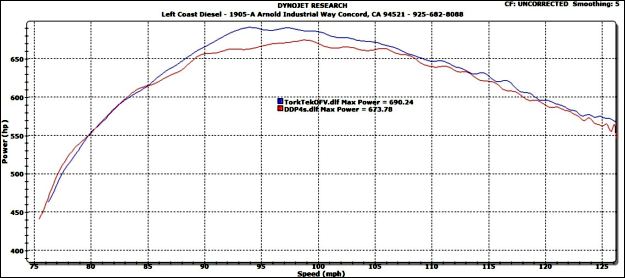High Performance Overflow Valve for Air Dog & Fass Pump Users - OFV050HP
Increase
your horsepower and fuel pressure! At full power it will raise your
fuel pressure in the range of 37 to 45 psi. For use on moderately
modified Cummins trucks. Works much better than the old Bosch valve with
.168 inlet orifice. Now you can win at your competition event!
Do you experience low fuel pressure at wide open throttle (WOT) and
just accept it as normal? Have you ever thought that low fuel pressure
gives your competitor an edge?
Anthony Reames, the technical manager at Air Dog, asked us to solve
the low fuel pressure problem with the Bosch P pump. Cummins owners
report that the fuel pressure drops to as low as 16 PSI during full
throttle runs. We jumped on this technical request because we thrive on a
challenge. Solving problems is what Tork Teknology is all about.
The first thing we did is throw all assumptions out the window. We
found that in most cases, they can be very misleading. Our slogan, that
we live by, is "one good test is equal to a thousand expert opinions".
This is how we attack a problem.

After installing an Air Dog II DF165 on our '98 Dodge Cummins test
truck, we routed the 1/2" feed line to an accurate flow meter and ran
all the return fuel through an additional flow meter. The fuel pressure
was monitored by a glycerine filled pressure gauge. The results (shown
left) align exactly with proven hydraulic formulas. Fluid will flow a
specific volume through an orifice at a specified pressure and specific
gravity. Simply put, a fluid will flow more volume (gpm) as the pressure
increases through the same size orifice. Put another way, reduce the
orifice diameter, and the GPM flow will drop.

You may have asked yourself why Air Dog and FASS equipped Dodge
Cummins trucks will show good fuel pressure at idle and cruise, but the
pressure drops at full throttle, to as low as 16 PSI. Take a look at the
photo above. The flow meter indicates diesel fuel flow of 1.09 GPM.
This is the volume of fuel flowing thru the inlet orifice at the base of
the overflow valve. (see photo right) Actually, it translates into 1.14
GPM (multiply number by 1.0495 correction factor) flowing into and out
of the P7100 pump. That is the volume of fuel flowing back to the
tank through the Cummins overflow valve. Yes, we tested both the Bosch
and Tork Tek overflow valves. If you are using one of the old Bosch
valves with the .168 inlet orifice, your fuel pressure will never allow
you to win ANY competition event becuase of very low fuel pressure.
ELECTRIC PUMPS DO NOT WORK WELL WITH THE P7100
UNTIL NOW
I'm not saying that the Air Dog and FASS are not good pumps. Both are
quality pumps. The problem is the orifice leakage is too large and
bypasses too much fuel to tank. This leakage produces low fuel pressure
at WOT.
We now know that the inlet orifice on a standard Bosch overflow valve
will flow 1.14 GPM back to tank. This is how it lowers your fuel
pressure and kills your Cummins diesel performance! If you run an
AirDog 100 GPH (gallons per hour) pump, you are pumping 1.66 GPM. (100
GPH divided by 60 minutes/hour = 1.66 GPM) You are losing 69% of your
pump volume thru the overflow valve. That's almost 75% of the fuel doing
no work at all! Let's do the numbers for the Air Dog II DF165 which is
rated at 2.75 GPM. If you lose 1.14 GPM to tank, 41% of your pumps
capacity is LOST. Let's suppose you use the AirDog II DF200 which flows
3.33 GPM. 34% of the pumps capacity is doing nothing for your
performance 12V Cummins.
It's easy to see why performance P pump users are showing low fuel
pressure at WOT. Too much diesel fuel is pumped through the Bosch
overflow valve and back to tank. This translates into lower HP and
torque performance numbers with your Cummins 12V. It could make the
difference between winning or going home defeated.
Another problem that we uncovered was at a very specific pressure,
the fuel flow through the overflow valve can be dead headed. This can be
dangerous as the P pump needs fuel flow to help keep it cool. If you
set the AirDog pressure regulator to slightly less than the OFV setting,
fuel flow and pump cooling STOP. Also if you adjust the OFV by
adjusting the shims, stretching the spring or adjust the Tork Tek
overflow valve, the same problem can exist. The solution had to cure low
fuel pressure and eliminate any possibility of stopping fuel flow thru
the valve.
WHAT ABOUT INJECTION PUMP COOLING?
We know from testing the Cummins 5.9 fuel system, with the stock lift
pump, that fuel flow is .59 GPM (max) at 2200 RPM. The engineers at
Bosch spent a lot of R & D time to make sure the P pump stayed cool
at the fuel flow the lift pump delivered. The Bosch P7100 injection pump
will run without problems for 300 to 500,000 miles or more! There are
commercial trucks that have seen 1,000,000 miles with the P pump and the
Cummins lift pump.
The smallest of the four valves is the OFV070HP. This valve is for
super modified, race only trucks. The 070HP orifice will flow .565 GPM
at 45 PSI. So, even with the smallest of the valves, you will still be
within 4% of the cooling capacity of a stock system.
THE NEW HP OVERLOW VALVE - A TESTED SOLUTION
How did we test for a solution? We machined 12 prototype overflow
valves with replaceable orifices, similar to Holley carb jets. The beta
testers could now replace the jet with a smaller one to the point where
the fuel pressure was aceptable at WOT. In other words, the fuel
pressure remained constant from idle to full throttle. Each jet change
and fuel pressure reading was documented on a chart. In addition, I made
the same tests on our '98 Dodge Cummins 12V.
It became clear after the testing was complete, which sizes cured the
problem. Each size created a fuel pressure range at WOT. We also
discovered that a very small change in orifice size will make a dramatic
change in fuel pressure and fuel flow.
FUEL PRESSURE MAKES HORSE POWER
To illustrate how fuel pressure can affect Cummins diesel horse power
and torque, one beta tester asked his brother to try the prototype
valve on a dyno. The owner of Left Coast Diesel made a run with a
standard Cummins OFV and then installed the prototype Tork Tek HP valve.
The first thing he noticed was consistent fuel pressure across the RPM
band. No other changes were made to the engine. He achieved a 27HP
increase for 3 minutes worth of work. His power increased from 663HP to
690HP at 93 MPH. That 27 peak HP increase can be the difference
between winning and losing.


What fuel pressure should you be running? Here is a general
rule to determine the fuel pressure you should be at. Multiply the
governor spring rpm (in thousands) times 10. In other words, you want 10
PSI of fuel pressure per 1000 RPM of govenor speed. If you installed a
3K govenor kit, you need a minimum of 30 PSI at full power. A 4K kit requires 40 PSI at WOT. 5K equals 50 PSI. Remember, this is at full power, not idle or cruise.
Fuel pressure will be in the 43 to 50 PSI range if you add the 40 PSI
spring. The standard spring will limit the fuel pressure you can reach.
If you are using the original Air Dog pump, it is factory set at 30
PSI. If you want higher fuel pressure, you will have to install a 40 PSI
spring. The AirDog I and II use different springs to achieve higher
fuel pressure. They are not interchangeable. Please note that you will
not achieve higher fuel pressure by swapping out the spring. You have to
fix the leak first.
Do not use the HP valve on a stock fuel system! This valve will raise
pressure spikes to the point that the stock fuel filter canister will
blow a seal. The valve is intended for Cummins P7100 trucks using a
FASS, Air Dog or high volume, performance fuel pump only.